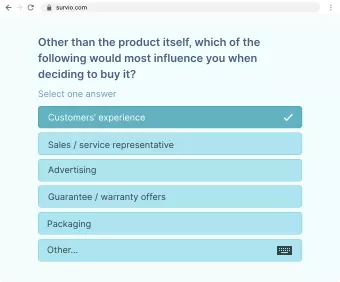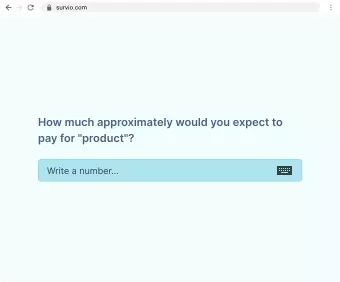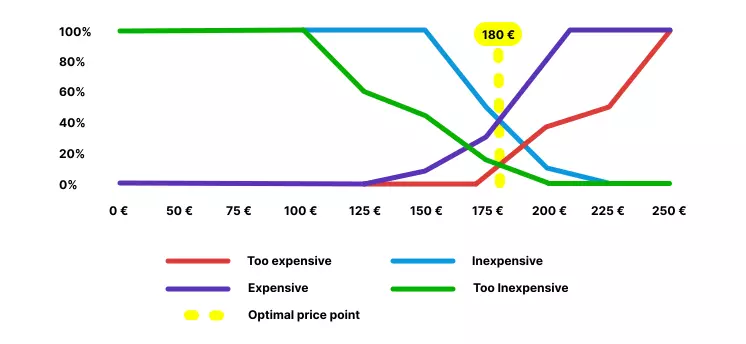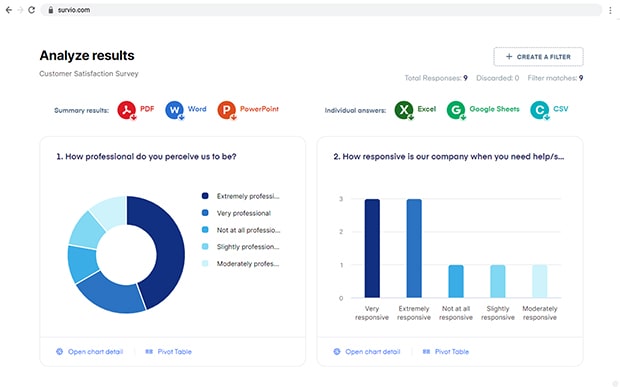
How to Create a Pricing Survey
Learn how to use surveys to find out how customer buying behaviour changes when you change the price.
Who is this article useful for?
- marketing specialists
- sales teams
- management

Learn how to use surveys to find out how customer buying behaviour changes when you change the price.
Who is this article useful for?
What happens if your product gets more expensive? Will your sales go down or not? Knowing how price sensitive your customers are will allow you to change prices with greater confidence. You will know how the market will behave, how it could affect your sales, which gives you useful hints as to expected turnover.
Of course, pricing is not just based on what your customers want. Your price is heavily affected by your costs and the margin you need. Even your competitors' prices are likely to push your prices down. However, if you set the prices only on the basis of costs or competition, you might be missing the point of how much customers would actually be willing to pay for your product. It may be more than you think. You need to ask customers about this and include their perspectives in your pricing strategy.
In this article you will learn:
Price sensitivity is the extent to which the price of a product affects a customer's demand or willingness to buy. It shows us how important price is as a purchasing decision factor. If a small change in price is enough to make your customer decide not to buy from you, this is a price-sensitive customer. If, on the other hand, the price change does not affect the customer and they buy anyway, he is a price-insensitive customer.
Brand loyalty - How much do your customers believe in your brand? Do they buy your products because they are yours or because you market them cheaper than your competitors?
Product availability - If you make your products more expensive, will it be easy for your customers to switch to your competitors? Is there a close alternative on the market? If not, customers will be less price-sensitive because they will not be able to find a solution for their needs elsewhere. They will therefore buy from you even at a higher price.
Customer attitude - How do your customers think when they take a look at a higher price? Does the price tag evoke higher quality? Or do they hold fast to the price they expected (reference price) and any price increase will drive them away from the product?
Are your customers enthusiastic about new technologies? It doesn't just have to be new products in the electronics market, it could be shoes made with new technology. If your customers welcome new products on the market (and they become so-called innovators), they will be less price-sensitive because they want to be among the first to own the product. They are not afraid that the product has not yet been tested by the public.
The goal is to find out how price-sensitive your target group is and what exactly affects its price sensitivity.
Ask your customers what price ranges are acceptable to them and what aspects may affect their price sensitivity. Take inspiration from the price sensitivity survey template. Feel free to modify the questions or its structure to meet your specific purpose.


You can also measure price sensitivity according to Van Westendorp. Peter Van Westendort, a Dutch economist (1976) came up with four questions that enable you to determine the most appropriate price. These questions are:

This chart shows the potential responses to all four questions together. You can see the optimal price point that customers would accept. You can also observe changes in their purchase intention once the price is changed.
The creation itself is no big deal. With Survio, you can have your survey ready in a few minutes. However, think first, then create the questions. You need to define what information you want to gather to deduce strategic decisions from. You also need to write down what demographic data you will collect to sort out different behavior between different groups. Only after you know the exact objectives of your survey, you can start creating the questions.
There are 19 question types to choose from that allow you to put together a perfect set of questions to reach your goal. To master creating questions, browse through our blog with various articles on different question types. Sometimes, choosing the right question type can be a bit tricky. When you use the wrong question type - for example a multiple choice instead of a single choice, collected data can get skewed, which prevents you from concluding the right outcomes.
Go ahead and create your experience with the survey builder, its user-friendly environment and intuitive navigation.
By fine-tuning all possible details you can make the survey more understandable for your respondents and increase the response rate. To be sure your survey is perfect, we highly recommend testing it in a preview. You can send it for example to your colleagues and let their feedback help you eliminate all typos and mistakes that could affect the quality of collected data.
Survio works great on a desktop as well as on mobile devices. In addition, it allows response collection on many distribution channels. Feel free to use those that are convenient for you and your audience to get solid feedback and increase the response rate. Take a look at the following ways of sharing your surveys:
Embed your survey into your website. Price sensitivity is usually determined on a product-by-product basis, so it is not recommended to embed your survey directly on the homepage. Place your questionnaire on a page that is dedicated to the product in question. This way people will see the product they are evaluating right away. There are three options of embedding a survey that you can select from:

All responses that you collect are processed automatically and in real time. The response analysis projects the data in summary results and individual answers, so that you don’t need any other statistical software. You can choose a number of views, involving professional charts and comprehensible tables to make sure that the presented overview is fully comprehensible to the audience.

Depending on further use of the results, it is possible to apply filters and display the data exactly the way you need. The output can be exported in modern reports and BI dashboards by a couple clicks, which saves your time and makes you ready for a presentation within seconds. Whether you wish to edit it or roll with what you get, you have a set of the most common formats at your disposal - PDF, .DOCX, .PPTX, .XLSX, .CSV or Google Sheets.
TIP: Are you going to measure price sensitivity according to Van Westendorp? Download your results in the .XLSX format and create the above mentioned chart consisting of 4 curves (responses to 4 different questions combined in one chart) to find out the optimal price point.
Did you manage to collect the results? Great. But you're not done yet. Results alone are not the goal of your survey. The goal is to map your customers' behavior from the results - to see how they react when the price changes.
Try to get an overall picture of how your sales volume changes when your price changes. In most cases, you will ask yourself: “How much will my sales decrease if I raise my price?” You can then calculate the exact price sensitivity.
![]()
Example: You find out that a 15% increase in the price of your software subscription makes your sales drop by 10%. Let’s calculate the price sensitivity:
![]()
You can interpret your result like this: if your price increases by one percentage point, your sales decrease by 0.67 percentage points. Knowing this you can set up an optimal price - you will know how much you can raise your price to keep the revenue as high as you need.
You may need to increase the price of your product by more than your customers will accept. Then a different set of sales methods like up-selling/bundling or selling add-ons comes into consideration. However, without knowing the exact price sensitivity, you would only go into these activities based on a gut feeling and not the data, which can lead to wasted resources.

Find out why our customers choose Survio as a reliable feedback solution for their business.
We hope that now you are fully equipped to embark on your own surveying. We wish you good luck!